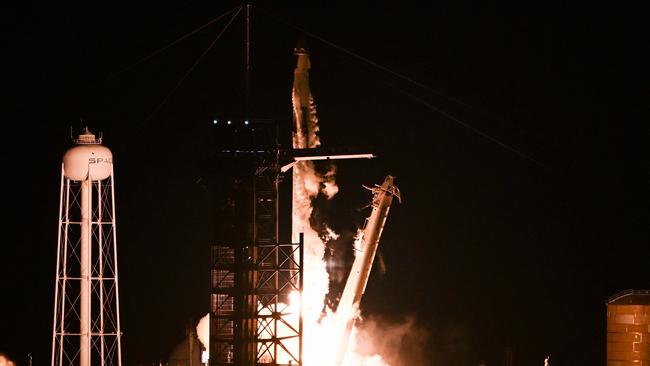Private astronauts on daring trek ahead of historic spacewalk
The SpaceX Polaris Dawn mission, led by Shift4 Payments CEO Jared Isaacman, launched from the Kennedy Space Centre in Florida late on Tuesday.

A private crew set out on an audacious orbital expedition on Tuesday, journeying deeper into the cosmos than any humans in half a century as they prepare for the first spacewalk by non-professional astronauts.
The SpaceX Polaris Dawn mission, led by Shift4 Payments CEO Jared Isaacman, launched from the Kennedy Space Centre in Florida late on Tuesday and attained its peak altitude of 1400km on Wednesday.
“Achievement unlocked – apogee 1400.7km,” SpaceX said on X .
That is more than three times farther from Earth than the International Space Station, as their Crew Dragon spaceship navigates through portions of the hazardous, high-radiation Van Allen belt during its roughly five-day trek.
Radiation isn’t the only challenge the four-member team faces: their spaceship “will travel repeatedly through the orbital altitudes of over 10 thousand satellites and bits of space debris,” said SpaceX founder and CEO Elon Musk. “No room for error in our calculations.”
The highlight of the voyage is slated for as early as Thursday: the first spacewalk by civilians, outfitted in sleek, newly developed SpaceX extravehicular activity suits with heads-up displays, helmet cameras and advanced joint mobility systems – once the orbit is back down to roughly 690km. SpaceX has scheduled the EVA for 4.23pm on Thursday, with a back-up window on Friday at the same time.
Since the Crew Dragon capsule lacks an airlock, the entire crew will be exposed to the vacuum of space for about two hours, as two crewmates venture out, in turn, for 15 to 20 minutes each.
On Tuesday, the capsule blasted off atop a Falcon 9 rocket after weather delays pushed back the launch several times.
Applause broke out across the mission control centre as it separated successfully from the main engine and the first glimpses of Earth came into view.
As they prepare for their spacewalk, the crew has been tasked with gathering data on decompression sickness and the health effects of the Van Allen radiation belt, a region teeming with high-energy charged particles.
While venturing deep into space, the crew won’t exceed the distances reached during the Apollo missions to the Moon from 1968 to 1972.
The farthest, 400,171km, was set by the Apollo 13 crew in 1970 as they looped around the Moon during an emergency return to Earth following an onboard explosion.
Mr Isaacman has remained tight-lipped on his total investment in the project, though reports suggest he paid around $US200m for the SpaceX Inspiration4 mission in September 2021, the first all-civilian orbital mission.
Rounding out the team are mission pilot Scott Poteet, a retired US Air Force lieutenant colonel; mission specialist Sarah Gillis; and mission specialist and medical officer Anna Menon – the latter two both SpaceX engineers who have now travelled further from Earth than any women before them.
The quartet underwent more than two years of training in preparation for the landmark mission, logging hundreds of hours on simulators as well as skydiving, centrifuge training, scuba diving and summiting an Ecuadoran volcano.
Polaris Dawn is the first of three missions under the Polaris program, a collaboration between Mr Isaacman and SpaceX.
The final mission is slated to be the first crewed flight of SpaceX’s Starship prototype – the rocket it envisions as the key to future Mars colonisation.
In addition to their spacewalk, the crew will test laser-based satellite communications between the spacecraft and Starlink’s satellite constellation, aiming to enhance space communication speeds.
They’ll also carry out 36 scientific experiments, including tests on contact lenses with embedded micro-electronics to monitor changes in eye pressure and shape – adding to the growing body of space research aimed at advancing human exploration beyond Earth.
AFP



To join the conversation, please log in. Don't have an account? Register
Join the conversation, you are commenting as Logout